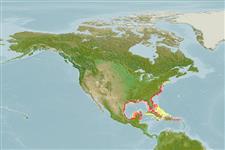>
Eupercaria/misc (Various families in series Eupercaria) >
Sparidae (Porgies)
Etymology: Lagodon: Greek, lagos = hare + Greek, odous = teeth (Ref. 45335).
More on author: Linnaeus.
Environment: milieu / climate zone / depth range / distribution range
Écologie
marin; eau douce; saumâtre démersal; profondeur 6 - 30 m (Ref. 44885). Subtropical; 42°N - 18°N, 98°W - 64°W
Western Atlantic: Massachusetts (USA), Bermuda, and northern Gulf of Mexico to Florida Keys, USA and Yucatan, Mexico. Also in northern coast of Cuba; absent in Bahamas or rest of Antilles (Ref. 26938).
Length at first maturity / Taille / Poids / Âge
Maturity: Lm 13.1, range 9 - 17.3 cm
Max length : 40.0 cm TL mâle / non sexé; (Ref. 3815); common length : 18.0 cm TL mâle / non sexé; (Ref. 3815); poids max. publié: 1.5 kg (Ref. 40637)
Commonly found on vegetated bottoms, occasionally over rocky bottoms and in mangrove areas. Enters brackish water and even freshwaters. Often forms large aggregations. Feeds mainly on small animals, especially crustaceans, but also takes mollusks, worms and occasionally small fishes that are associated with the grassy habitat. Depth range based on the depth at which this species was captured by trawls during a baitfish survey (Ref. 44885); to be replaced with a better reference.
Life cycle and mating behavior
Maturité | Reproduction | Frai | Œufs | Fécondité | Larves
Robins, C.R. and G.C. Ray, 1986. A field guide to Atlantic coast fishes of North America. Houghton Mifflin Company, Boston, U.S.A. 354 p. (Ref. 7251)
Statut dans la liste rouge de l'IUCN (Ref. 130435: Version 2024-1)
Menace pour l'homme
Harmless
Utilisations par l'homme
Pêcheries: intérêt commercial mineur; pêche sportive: oui; appât: usually
Outils
Articles particuliers
Télécharger en XML
Sources Internet
Estimates based on models
Preferred temperature (Ref.
123201): 22.8 - 26.7, mean 24.3 °C (based on 181 cells).
Phylogenetic diversity index (Ref.
82804): PD
50 = 1.0000 [Uniqueness, from 0.5 = low to 2.0 = high].
Bayesian length-weight: a=0.01349 (0.01201 - 0.01516), b=3.05 (3.02 - 3.08), in cm total length, based on LWR estimates for this species (Ref.
93245).
Niveau trophique (Ref.
69278): 4.4 ±0.0 se; based on diet studies.
Résilience (Ref.
120179): Milieu, temps minimum de doublement de population : 1,4 à 4,4 années (tmax=7; k >0.30).
Fishing Vulnerability (Ref.
59153): Low to moderate vulnerability (34 of 100).
Nutrients (Ref.
124155): Calcium = 88.2 [51.7, 185.8] mg/100g; Iron = 1.09 [0.60, 1.99] mg/100g; Protein = 20.3 [19.3, 21.4] %; Omega3 = 0.429 [0.269, 0.714] g/100g; Selenium = 17 [8, 36] μg/100g; VitaminA = 13.9 [4.2, 44.4] μg/100g; Zinc = 0.762 [0.506, 1.100] mg/100g (wet weight);
